Local
Organizing Committee ISMB 2006 Members
|
|||||||||
| EMBRAPA/CNPTIA |
LBI,
Unicamp Campinas, SP @ |
Alellyx
Applied Genomics and LBI, Unicamp Campinas, SP @ |
|||||||
| USP São Paulo, SP @ |
|||||||||

Goran Neshich |
Goran Neshich, Ph.D., is
a Structural BioInformatics (SBI) group leader at the Brazilian Agricultural
Research Corporation (EMBRAPA), Nacional Agricultural Information
Technology Research Center (CNPTIA), Campinas - SP, Brazil. Neshich
started his work in structural bioinformatics while studying structure
and function relationship of the photosynthetic reaction center during
his graduate work done with Don DeVault at the University of Illinois
at Urbana-Champaign. He conducted his postdoctoral research with Barry
Honig at Columbia University. Neshich is the principal author of STING
and the STING Millennium Suite, a popular software application for
presentation of macromolecular interactions, structure analysis, and
visualization. STING is accessible from the Protien Data Bank (PDB),
www.pdb.org. He is
continuing to develop tools for comprehensive presentation of physical-chemical
properties of proteins (Protein Dossier) and applying those to generate
structure/function descriptors. His latest initiative is developing
the Protein Dossier to be suitable for presentation of results obtained
and used in drug and drug target identification and chemogenomics.
More about his research may be found at www.cbi.cnptia.embrapa.br.
|
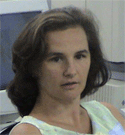 Paula Kuser Falcão |
Paula Kuser, Ph.D., is a researcher at the Brazilian Enterprise for Research in Agriculture (EMBRAPA), Informática Agropecuária, Campinas, Brazil, working in the Structural BioInformatics Group. Kuser's research focuses on the determination and analysis of protein structure and function, and protein structure comparison, prediction and modeling. Kuser obtained her Ph.D. in 1993 from Birkbeck College, University of London where she worked in the Crystallography Department, with advisor Peter Lindley. Kuser conducted postdoctoral research as a fellow at The Wistar Institute and at the Brazilian Synchrotron Light Source Laboratory, where she established the crystallography laboratory. Following this, Kuser joined the Structural BioInformatics group; working on the development of tools for comprehensive presentation of physical-chemical properties of proteins within the Sting Millenium Suite. More about her research may be found at www.cbi.cnptia.embrapa.br. |
 Álvaro Seixas Neto |
Álvaro Seixas Neto
is a researcher at the Brazilian Agricultural Research Corporation
(EMBRAPA), Nacional Agricultural Information Technology Research Center
(CNPTIA), Campinas - SP, Brazil. Seixas Neto has a B.Sc, in Economical
Science from the Faculdade de Economia e Administração
at Universidade de São Paulo (USP) and a M.Sc. in Rural Economy
at Universidade Federal de Viçosa (UFV). Seixas Neto has served
as main chief of CNPTIA for seven years, and presently he is the coordinator
of the Business and Communication Department (ACN). The ACN concentrates
its efforts in the establishment of business with partners, technology
transfer, and in intensifying the communication with the market. |
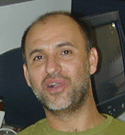 Gonçalo Amarante Guimarães Pereira |
|
 João Carlos Setubal |
João Carlos Setubal is Associate Professor of the Institute of Computing, University of Campinas (Unicamp). He has a Ph.D. degree in Computer Science from the University of Washington (1992). Setubal is co-author with Joao Meidanis of "Introduction to Computational Molecular Biology", a well-known textbook in bioinformatics, adopted at MIT and elsewhere. Setubal was one of the founders, in 1997, of the Bioinformatics Laboratory of Unicamp. This lab was created to provide bioinformatics support for the first Brazilian genome project, that of the plant pathogen Xylella fastidiosa. More recent projects in which Setubal led bioinformatics teams are Xanthomonas axonopodis pv. citri, Xanthomonas campestris pv. campestris, Agrobacterium tumefaciens, and Xylella fastidiosa of grapevine. Setubal spent a sabbatical year (2001) in the department of Genome Sciences of the University of Washington, working with Phil Green. Setubal is also a director at Alellyx Applied Genomics, a newly founded biotech company. In 1996, Setubal was one of the organizers of the Brazilian school of computing, a five-day biennial event that had about 700 participants. |
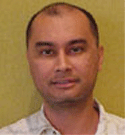 João Paulo Kitajima |
João Paulo Kitajima, Docteur en Informatique [Grenoble, France], is a Bioinformatics researcher and was one of the coordinators of the bioinformatics Laboratory at the Institute of Computing in Unicamp, J.P. Kitajima graduated in Computer Science at the University of Brasilia, getting a master degree in Computer Science at the Rio Grande do Sul Federal University and Ph.D. in Informatics at the Institute National Polytechnique de Grenoble (INPG), France. Kitajima held positions at the University of Brasilia in 1995 and at the Minas Gerais Federal University from 1996 to 1998. He advised master students and was responsible for courses related to Operational and Parallel Systems. He has been working since 1999 in a variety of Genome and transcriptome projects, assembling bacterial genomes in silico(e.g. Xylella fastidiosa responsible for Pierce's Disease), clustering sequences of transcript genes (e.g. Schistosoma mansoni, a human parasite) and giving support for the annotation of the sequences generated by these projects. He was involved in genome project of the bacteria Xylella fastidiosa and Xanthomonas and, more recently, in collaboration with the University of Washington , the Agrobacterium tumefaciens bacteria. Kitajima is co-founder of Alellyx Applied Genomics, a private initiative targeted to solve agricultural problems using genomic technology. Finally, Kitajima was the general chair of the XVIII Computer Science National Conference, organized in 1998 by the Brazilian Computer Society and held in Belo Horizonte, Minas Gerais State. |
 José Antonio Maranho |
JOSÉ ANTONIO MARANHO was born in Potirenbada, State of São Paulo, Brazil, on July 20, 1937. He is graduated in Laws, Journalism, Public Relations and Administration. He started as Journalist in 1957. After he worked with a Brazilian subsidiary of the American multinational Clark Equipment Co. (1959-1983, where became Vice President of Human Resources and Public Relations. He was Founder (1965) and then President (1970-1971) of the Brazilian Human Resources Association. He was Director of the powerful FIESP - Federation and Center of the Industries of the State of São Paulo (1966-1971). He was Mayor of Paulínia (city with one of the biggest chemical and petro-chemical parks of Brazil (1976-1979). He represents FIESP in the CONSU - UNIVERSITY COUNCIL of UNICAMP, during the last seven years. He is owner of the companies of the VERTICAL GROUP (organizer of Events, Tourism and Marketing). As PCO, he had already organized hundreds of Conventions for companies as 3M, SIEMENS, ANTARCTICA, SEAGRAM, EFFEN, BRASMOTOR, IBM, etc., as well as commercial and professionals missions to Europe and to the United States of North America. He has been organizing hundreds of Congresses, Fairs and Expositions, since 1984, as CONARH - NATIONAL HUMAN RESOURCES ADMINISTRATION CONGRESS (the second biggest HR event in the world. The CONARH 2002 had 12.000 participants); AVIESTUR business fair of tourism (it is the most important in South America, with 5.000 participants during each one); CBM - BRAZILIAN CONGRESS OF MICROBIOLOGY (3.000 participants); BRAZILIAN CONGRESS OF HYPERTENSION; HEMATOLOGY and HEMOTHERAPY BRAZILIAN CONGRESS; NATIONAL CONFERENCE OF CANCER; BRAZILIAN CONGRESS OF MICROBIOLOGY AND FOOD HYGIENE; INTERNATIONAL CONGRESS OF PHARMACY, all of them with more than 1.500 participants; WORLD CONGRESS OF COLOPROCTOLOGY, with more than 2.00O participants, and others. He was Professor of General Theory of Administration in the PUCC - Pontifícia Universidade Católica de Campinas - Catholic University of Campinas, during six years. JOSÉ ANTONIO MARANHO had travel to the five continents and know all Brazilian States. |
 Rogério Meneghini |
Rogério Meneghini, Ph.D., is an associate director at the National Laboratory of Synchrotron Light Source (LNLS), Campinas, São Paulo, Brazil. His main areas of research are: biochemistry and molecular biology of the action on DNA of reactive oxygen species; importance of iron homeostasis on the redox status in the cell; and assessment in research and technology. Meneghini is the coordinator of the Structural Molecular Biology Network for the study of the 3D structures of proteins in São Paulo state. Meneghini has spent sabbaticals in the National Institute of Environmental Health Sciences, in North Carolina, (1972 -1973); Stanford University, Department of Biology, Philip Hanawalt laboratory, (1973-1974); Mutation Research Unit, University of Sussex (1982); and Department of Experimental Oncology, University of Ottawa, laboratory of C. H. Birnboim, (1989-1990). Meneghini is an assistant to the scientific director of the Sao Paulo State Foundation of Support to Science (FAPESP), since 1992. Meneghini's work was cited by the Institute of Scientific Information Atlas of Science, in 1988, as key contributor in biochemistry. He is a member of the Brazilian Academy of Sciences. |
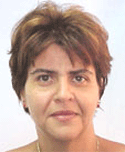 Ana Tereza Ribeiro de Vasconcelos |
Ana Tereza Ribeiro de Vasconcelos is the head of the Bioinformatics Laboratory - LABINFO in the National Laboratory for Scientific Computation - LNCC. Ana Teresa Vasconcelos obtained her Ph.D. in Biological Sciences (Genetics) in 2000 from the Federal University of Rio de Janeiro, working with small extragenic interrupted palindromes in the bacterial genome. Vasconcelos is the bioinformatics coordinator of the Brazilian Genome Project - BRGENE (http://www.brgene.lncc.br), the Rio de Janeiro Genome Project - RIOGENE (http://www.lncc.br/~riogene), and the Southern Genome Investigation Project -PIGS (http://www.lncc.br/~genesul). She is also the course coordinator of a postgraduate lacto sensu in bioinformatics. Vasconcelos' bioinformatics group is also involved in cooperation projects like:· Analysis of small palindromes occurrences (IBCCF/UFRJ); multidisciplinary integrated bioinformatics research center of Santa Catarina (UFSC); Bioinformatics applied to Schistosoma mansoni genome and other parasites - René Rachou Research Center - Oswaldo Cruz Foundation; Bioinformatics applications in the pos-genome areas with higher demand for CPU´s (Embrapa, LNLS, UFPE, TECPAR and LABINFO/LNCC); Photodissociation of biomolecules analyzed by TOF-TOF (PUC-RIO, UNIRIO and LABINFO/LNCC. Event Organization: Summer school in Computational Methods in Biology - LNCC/MCT (Jan. 2000). II Summer school in Computational Methods in Biology - LNCC/MCT (Jan. 2001). First Course of Bioinformatics - LNCC/MCT (Feb-Jun. 2002). Second Course of Bioinformatics- LNCC/MCT (Aug - Nov 2002). |
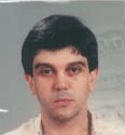 Junior Barrera |
Junior Barrera was born on September 8, 1959, in the city of São Paulo, SP, Brazil. Being graduated in Electric Engineering with emphasis on Automatic Controlling (EPUSP), Junior did his Master's degree on Applied Computer System (INPE), and his doctorate on System Engineering (EPUSP). He has founded and also coordinates the group of mathematical morphology at the IME-USP, which has offered relevant contributions in representation, project, and application of morphological program devices. As for his academic production, one finds the book "Bases da morfologia matemática para a análise de imagens binárias" ("Foundations of mathematic morphology for analysis of binary images"), which has been written together with Dr. Gerald Banon, and dozens of articles, which have been written together with some revisers, including publications at the PAMI-IEEE and the SIAM. Also, Junior has two international patents, and developed together with Dr. Roberto de Alencar Lotufo a software of great success for imaging morphological analysis, as well as takes part on the editorial staff of the "Journal of Electronic Imaging" and "Pattern Recognition" journals. Nowadays, Junior Barrera is an associate professor at the IME-USP , and have already supervised 5 students for the Master's degree and 4 students for the doctorate , a main researcher on two thematic projects for FAPESP, and the president of the "Núcleo de Pesquisa em Bioinformática da USP". Among this set of activities, he also collaborates intensively at both national and international levels to the National Human Genomic Research Institute for data analysis of genetic expression. His main interests include a project of morphological program devices for imaging analysis, pattern recognition, identification of dynamic systems, and bioinformatics . Editorial activities: - Pattern Recognition. Journal of the international society for Pattern Recognition - Journal of Eletronic Imaging - SPIE. International Conferences - SPIE - International Conference relevant in the area of image processing and signs - ISMM- World Conference in the area of Mathematical Morphology. ISMM´98- Internacional Symposium on Mathematical Morphology, 3-5 Junho, Amsterdã. - International conference on scale space. International Events: - Coordenator of the "First Latin American Course on Bioinformatics applied to Tropical Diseases", University of São Paulo- Brazil, February,17th to March 2nd, 2002. |
 Sergio Verjovski Almeida |
Sergio Verjovski-Almeida, Ph.D., is a full professor of biochemistry in the Chemistry Institute at the Universidade de São Paulo, Brazil. Verjovski-Almeida is the group leader of the Laboratory of Structure and Function of ATPases. His group works with calcium-ATPase focusing on understanding at the molecular level the mechanism of energy conversion involved in ion transport catalyzed by this enzyme and with Schistosoma mansoni ATP-diphosphohydrolase a membrane protein. His lab was a member of the Xylella Genome project, which has sequenced Xylella fastidiosa, the first plant pathogen to have its genome completely sequenced. The project has been completed in March 2000. Verjovski-Almeida coordinated one of the five sequencing centers which comprised the FAPESP/Ludwig Institute "Human Cancer Genome Project", a two-year project aimed at obtaining 1,000,000 EST sequences from human tumor cells. The project started on March 1999 and reached its goal on March 2001. His lab was one of ten Bioinformatics associates, and developed some sequence analysis tools. His group is currently working on the multi-disciplinary departmental research project denominated "CAGE- Cooperation for Analysis of Gene Expression". Verjovski-Almeida coordinates CAGE/Cancer, a cooperation between the Institute of Chemistry, the Albert Einstein Jewish Hospital/SP and the Cancer Hospital/RJ to study prostate cancer; Verjovski-Almeida coordinates the Schistosoma EST Genome Project, a network of nine research laboratories in the State of São Paulo funded by FAPESP to generate 180,000 EST sequences from the parasite. Verjovski-Almeida is an associate member of the Brazilian Academy of Sciences. More about his research may be found at http://verjo2.iq.usp.br/. Verjovski-Almeida was the organizer of the "Mini-Symposium on Ion Transport ATPases" at the Annual Meeting of the Brazilian Biochemical Society, May 1995, with 3 international speakers and 2 brazilian speakers. |
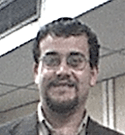 Sandro José de Souza |
Sandro
José de Souza, Ph.D. in Biochemistry and Molecular Biology,
is a research fellow and head of the Laboratory of Computational
Biology at the Sao Paulo Branch of the Ludwig Institute for Cancer
Research. De Souza obtained his Ph.D. in 1993 from the Universidade
de São Paulo and conducted postdoctoral research in the Molecular
and Cell Biology at Harvard University. De Souza's research focuses
on bioinformatics, genomics and molecular evolution. In bioinformatics
his group has developed a series of tools and made them available
to the community. In genomics, they are focused on the characterization
of the human transcriptome. The Laboratory of Computational Biology
have been involved with the Human Cancer Genome Project and have
spent some time studying alternative splicing. In molecular evolution
their major interests are the origin of new genes and the role of
exon shuffling during evolution. De Souza's other activities include
the position of director, at the Fundacao Antonio Prudente, Sao
Paulo, Brazil. During 1998-2002, De Souza's was a visitant professor
in the Bioinformatics Center at the National University of Singapore.
Event Organization: Co-organizer of the 1st
International Symposium on Extracellular MAtrix (Sep. 2000). Member
of the Organizing Comittee, 1st Brazilian International Genome Conference(Mar
2001). |
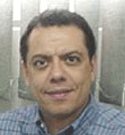 Glaucius Oliva |
Glaucius Oliva is Professor of Physics at the University of Sao Paulo and Director of the Center for Structural Molecular Biotechnology/FAPESP, in Sao Carlos, Brazil. His main research interests are structural biology and its application in drug design and discovery. His PhD was obtained at the University of London in 1988. His research group is composed of 50 members with a multidisciplinary composition of physicists, biologists and chemists. He has published 85 papers in international scientific journals. He is an International Scholar of the Howard Hughes Medical Institute (USA). Amongst his recent contributions, he has lead several protein crystallisation experiments on board of the NASA space shuttles, related to his studies on tropical diseases. He was profiled by Time Magazine and CNN, in May/1999, as one of the 50 Latin American Leaders for the New Millennium. Event Organization: • Member of the Scientific Advisory Committee of the Congress “Biophysics and Synchrotron Radiation-98”. Chicago, 1998 • Member of the Scientific and Program Committee of the 18th Congress and General Assembly of the International Union of Crystallography, Scotland, 1999. • Chairman and organizer of the 7th International Congress “Biology and Synchrotron Radiation”, BSR-2001, Brazil, 2001. Others: • Organizer os several symposia at the Annual Meetings of the Brazilian Biochemistry and Molecular Biology Society, hold annualy in Caxambu, Brazil (1994,1995,1996). • Chairman of the Annual Meeting of the Brazilian Crystallographic Society, 1990. |
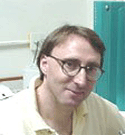 Richard Charles Garrat |
Richard Garratt is a structural biologist and associate professor at the Institute of Physics at Sâo Carlos (IFSC). He undertook both his undergraduate and post-graduate studies at the University of London, where he worked with Janet Thornton on algorithms for predicting secondary structure for his Masters thesis and on protein crystallography and X-ray absorption spectroscopy with Peter Lindley for his doctorate. He moved to Brasil in 1989 as a post-doc at the IFSC where he has worked ever since. His current interests are principally based around the structural biology of tropical parasites and he uses both experimental and theoretical approaches towards the use of structural biology in both drug and vaccine design. He was one of the first users of homology-based approaches to protein modeling in Brasil. Over the last few years he has enjoyed fruitful collaborations with groups involved in the S. mansoni gene discovery program, which has led to the determination of the crystal structures of potential drug targets such as purine nucleoside phosphorylase and Cu,Zn, superoxide dismutase. Garrat was one of the organizers of the VII International Congress on Biology and Synchrotron Radiation which happened in Sao Pedro , SP in 2001. He also participated in the organization of symposiums in events like Biophysics Congress of the Southern Cone, Annual meeting of the Brazilian Society of Biochemistry and Molecular Biology, Chagas Disease. |














